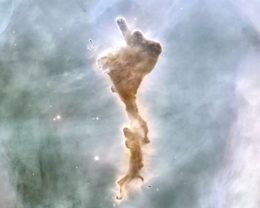Let’s be honest: the universe has an awful lot of gas. But the gas discovered in a new study isn’t your run-of-the-mill atomic gas! We’ve now found dense, star-formation-enabling molecular gas farther out than ever before.
A Crucial Ingredient

A Hubble view of a molecular cloud, roughly two light-years long, that has broken off of the Carina Nebula. [NASA/ESA, N. Smith (University of California, Berkeley)/The Hubble Heritage Team (STScI/AURA)]
You can’t get star formation without molecular gas; this cold, dense material forms the fuel that can eventually collapse into hydrogen-fusing cores. This means that hunting molecular gas can give us insight into how galaxies build up and form their stellar populations: molecular gas reservoirs actively feed violently starbursting galaxies throughout the universe.
Molecular gas is also often associated with the host galaxies of distant quasars, supermassive black holes accreting vast amounts of matter and shining brightly. By studying the properties of this molecular gas, we can learn more about how supermassive black holes evolve with their host galaxies.

Intensity maps of CO line emission show two locations of molecular gas: PSO145+19 and PSO145+19N. The blue cross marks the location of the known quasar. Click to enlarge. [Koptelova & Hwang 2019]
Looking Back in Time
Because galaxy formation and evolution is very much a big-picture question, we might wonder how molecular gas was different in the early universe. Did early star-forming galaxies contain more molecular gas than today’s galaxies? What were the properties of the gas? How did early galaxies form and evolve, creating young stars and feeding their central black holes?
To answer these questions, we need to hunt for large reservoirs of molecular gas at high redshifts. But this is challenging! The most common component of molecular gas, molecular hydrogen, isn’t easily detectable. For this reason, we turn to carbon monoxide (CO) as a tracer of molecular gas reservoirs.
So far, the most distant detections we’ve made of molecular gas using CO emission are at redshifts of z = 6–6.9. But now a pair of scientists from National Central University in Taiwan have looked even farther.
Drama of a Distant Interaction
Using observations of CO emission lines, Ekaterina Koptelova and Chorng-Yuan Hwang have discovered two sources containing molecular gas at a redshift of z = 7.09. That’s 13 billion light-years away, or from a time when the universe was just ~700,000 years old!

ALMA spectra of PSO145+19 (top panels) and PSO145+19N (bottom panels) reveal spectral lines corresponding to CO emission and water emission. [Koptelova & Hwang 2019]
The properties of the sources lead the authors to suggest that the gas may be tracing two or more star-forming galaxies that are interacting in the early universe. These colliding monsters contain reservoirs of molecular gas to fuel their star formation, as well as at least one quasar.
Future observations will hopefully confirm this picture and help us to better understand the role that molecular gas plays in the dramatic formation and evolution of galaxies in the early universe.
Citation
“A Luminous Molecular Gas Pair beyond Redshift 7,” Ekaterina Koptelova and Chorng-Yuan Hwang 2019 ApJL 880 L19. doi:10.3847/2041-8213/ab2ed9

1 Comment
Pingback: Tracking Gas in Star-Forming Galaxies